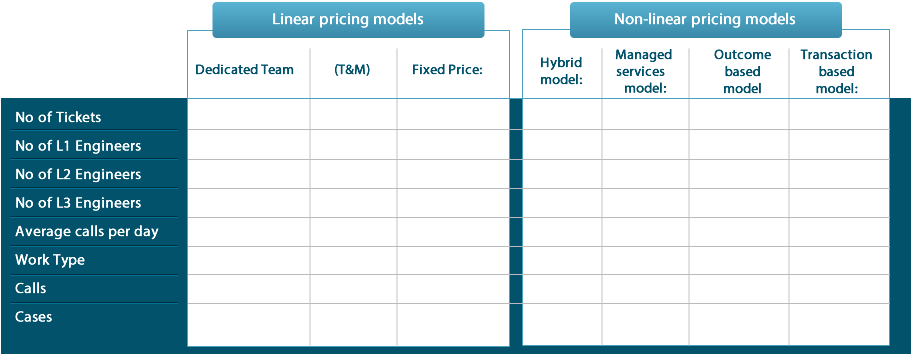We offer different pricing models for system integrators & end clients from the traditional Time & Material based and fixed price based, to mutually beneficial pricing models, to right balance between the client’s expectations of quality, timeliness and price, and the service provider’s cost and operational efficiency.

This model offers a dedicated team to the client or System Integrators for a defined period of time. It’s like all- you- can- eat plan. The client takes the onus of getting work done effectively from the team. Advantages of this model include knowledge retention and the flexibility of utilizing the team for different requirements.
This model offers flexibility to the clients & system integrators where the requirement changes frequently. We assign a dedicated team to the client and the actual time spent by the team on the project is billed.
The fixed price model is ideal for small and medium level projects with clear and well-defined requirements. But, as per the agreed contract, any change in the scope would result in a change in the price. Fixed price models allow customers to pay a fixed price for a project that is agreed upon by both the parties. The fixed price could be split and paid on milestones. Client has to be crystal clear the scope and specifications of the project from the very beginning and system requirements should be defined clearly.
This is the best pricing which we offer for the big and long projects where the objectives are unclear at the start. The hybrid model uses T&M techniques to estimate costs for projects that do not have clear-cut goals or detailed and complete requirements initially. It then allows customers to pay a fixed price based on the estimation.
The managed services model offers defined service deliverables at a fixed cost. Traditionally, values are defined according to how well we manage and how well it is perceived by the client. This is more qualitative in nature. In the managed services model on the other hand, the value-add is quantitatively measured in terms of target Service Level Agreements (SLAs). This is based on clearly defined parameters in project performance and quality
Today clients go beyond T&M and demand out come based pricing model, the margins are completely based on the certain percentage of revenue. Outcome-driven solutions are pin-pointed and positioned as delivering specific value to the business. Outcome-based projects aim to deliver measurable impact on the customer’s overall business results
It is generally a ticketing based model, prices are define per ticket or case handled by the team price would be decided based on the quantity of cases per day or month.

